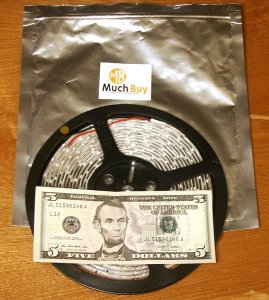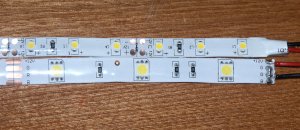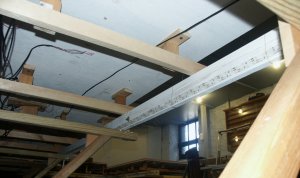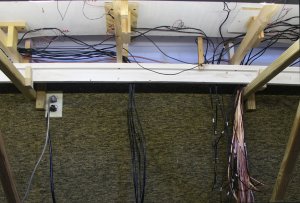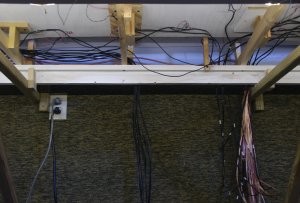videobruce
Tower Operator
Though I'm surely not the first to think about this, I though a thread on the subject would be worth while.
I needed lighting under my layout for wiring and I got tired of using a florescent trouble light to do the job. I thought about fluorescent tubes, but ruled those out as did with CCFL's due to size, heat, and the number that would be needed for even lighting. The only other choice is LED's, but the typical enclosure or the LED "bulb" gets me back to the above (without the heat issue). Then there is the cost.
One point I want to make;
I ruled out Xmas tree light strings and those awful looking "rope lights". I spent too much time and money on my layout to degrade it by going cheap.
Some preliminary details are needed. The most common SMD's (Surface Mount Device) used for these strips are the 3528 and the 5050. A comparison between the two is here;
http://www.ledlightsworld.com/page.html?id=32
http://www.flexfireleds.com/pages/Comparison-between-3528-LEDs-and-5050-LEDs.html
The issue of color temperature is here which is a huge issue with LED's;
http://www.digikey.com/us/en/techzone/lighting/resources/articles/understanding-the-color-white.html
There is also light output in lumen's which is not always listed. Something I consider the most important spec other than temperature;
http://www.colorkinetics.com/support/whitepapers/Evaluating_Light_Output.pdf
To make matters worse, there is a issue of "binning" due to the inconsistancy of mass production of LED's;
http://www.digikey.com/us/en/techzone/lighting/resources/articles/decoding-led-bin-labels.html
Now, if I haven't scared you away or confused the hell out of you, read on.
I knew of these "strips", but never looked into them. Doing some preliminary searches brought me to everyones favorite eBay. Searching there brings up dozens of sellers, mostly from Hong Kong that I didn't want to deal with. Checking "US only" removes most of those, but still leaves some since they are now just stating they ship to the US to get around the "US only".
Try this search. It reduces the count down to 530 sellers;
http://www.ebay.com/sch/String-Ligh...led+flexible+LED+lighting+strips&LH_PrefLoc=1
For those of you that don't like eBay, here is a link for a Amazon search (fine tuning may be necessary);
Amazon.com: led flexible strip lighting
All of the above are also available in aluminum housings, but at a higher cost.
If you don't want to bother, or have some other reason, there are these 'fixtures" available;
http://www.amazon.com/Bright-LED-cabinet-panels-powersupplies/dp/B003AKCT5G/ref=cm_cr_pr_pb_t
I needed lighting under my layout for wiring and I got tired of using a florescent trouble light to do the job. I thought about fluorescent tubes, but ruled those out as did with CCFL's due to size, heat, and the number that would be needed for even lighting. The only other choice is LED's, but the typical enclosure or the LED "bulb" gets me back to the above (without the heat issue). Then there is the cost.
One point I want to make;
I ruled out Xmas tree light strings and those awful looking "rope lights". I spent too much time and money on my layout to degrade it by going cheap.
Some preliminary details are needed. The most common SMD's (Surface Mount Device) used for these strips are the 3528 and the 5050. A comparison between the two is here;
http://www.ledlightsworld.com/page.html?id=32
http://www.flexfireleds.com/pages/Comparison-between-3528-LEDs-and-5050-LEDs.html
The issue of color temperature is here which is a huge issue with LED's;
http://www.digikey.com/us/en/techzone/lighting/resources/articles/understanding-the-color-white.html
There is also light output in lumen's which is not always listed. Something I consider the most important spec other than temperature;
http://www.colorkinetics.com/support/whitepapers/Evaluating_Light_Output.pdf
To make matters worse, there is a issue of "binning" due to the inconsistancy of mass production of LED's;
http://www.digikey.com/us/en/techzone/lighting/resources/articles/decoding-led-bin-labels.html
Now, if I haven't scared you away or confused the hell out of you, read on.
I knew of these "strips", but never looked into them. Doing some preliminary searches brought me to everyones favorite eBay. Searching there brings up dozens of sellers, mostly from Hong Kong that I didn't want to deal with. Checking "US only" removes most of those, but still leaves some since they are now just stating they ship to the US to get around the "US only".
Try this search. It reduces the count down to 530 sellers;
http://www.ebay.com/sch/String-Ligh...led+flexible+LED+lighting+strips&LH_PrefLoc=1
For those of you that don't like eBay, here is a link for a Amazon search (fine tuning may be necessary);
Amazon.com: led flexible strip lighting
All of the above are also available in aluminum housings, but at a higher cost.
If you don't want to bother, or have some other reason, there are these 'fixtures" available;
http://www.amazon.com/Bright-LED-cabinet-panels-powersupplies/dp/B003AKCT5G/ref=cm_cr_pr_pb_t
Last edited by a moderator:

